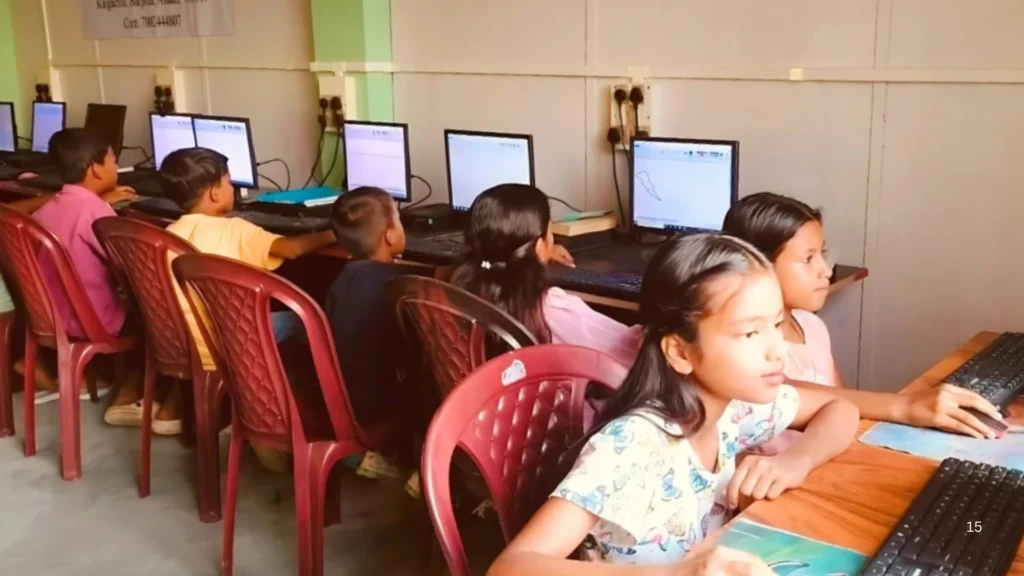“School’s not working for my child, but full-time homeschooling feels risky.”
If you’ve ever had that thought, this blog is for you.
Traditional schooling in India often feels rigid. The daily routine, the pressure of grades, the long commutes, it can all become too much for kids and parents. On the other hand, full-time homeschooling sounds appealing, but also overwhelming.
That’s where Hybrid Homeschooling comes in, a middle path between full-time school and full-time home education.
But before you jump in, let’s break it all down. What hybrid homeschooling actually is, how it works in India, and whether it’s the right fit for your family. We’ll keep it simple, honest, and useful.
What is Hybrid Homeschooling?
Imagine your child goes to school two or three days a week and studies the rest at home with your guidance or through online platforms. That’s Hybrid Homeschooling.
It’s a flexible learning model where students:
- Attend school part-time (physical or online classes)
- Learn from home the remaining time
- Follow a personalized learning plan
- Mix traditional subjects with passion-based learning
- Stay connected to peers without the pressure of full-time schooling
It’s not about choosing between home or school, it’s about combining the best of both.
Pros of Hybrid Homeschooling in India
1. Flexibility That Actually Works
One of the biggest benefits of hybrid homeschooling is its unmatched flexibility. Your child no longer has to live by the strict 8:00 AM to 3:00 PM bell system.
You get to design a schedule that works for your child, not one that burns them out.
Got a late riser? Let them start learning at 10 AM.
Need to travel during the off-season? Take your vacation in November without “leave not granted” stress. Does your child learns faster in the evening? That works too.
This kind of flexibility is especially helpful for Indian families living in Tier 2 and Tier 3 cities where access to good schools may be limited. With hybrid homeschooling, quality education doesn’t depend on your pin code.
It’s not just about saving time. It’s about giving your child control over their learning rhythm, which increases motivation, focus, and confidence.
2. More Time for Passions and Talents
Let’s face it, the current school system barely leaves room for passion.
Your child may love robotics, music, coding, or art, but after 6 hours of school and 2 hours of homework, they’re exhausted. Hybrid learning flips that. It gives your child dedicated time every week to pursue what truly excites them.
Want to explore painting? They can do a proper course, not just a 30-minute art period.
Into robotics? They can spend 3 hours building projects without being rushed for “unit tests.”
When children have time and freedom to follow their interests, their learning becomes more meaningful. Passion-based learning is one of the most underrated advantages of hybrid homeschooling in India today.
3. A Stress-Free Learning Environment
Hybrid homeschooling creates a calmer, safer, and more emotionally supportive environment for learning.
Gone are the daily pressures of:
- Competing with 50 classmates
- Coping with surprise tests
- Dealing with bullying or school anxiety
- Memorizing just to score in exams
Instead, students learn at their own pace, often with real-world relevance, using methods that suit their learning style.
This low-stress atmosphere is one of the biggest reasons parents in metros like Bengaluru, Mumbai, and Delhi are switching to hybrid models. Kids learn better when they’re not under constant stress.
4. Active Parental Involvement
Unlike traditional schooling, where parents are mostly spectators, hybrid homeschooling puts parents in the driver’s seat.
You’ll know:
- What your child is learning
- Where they’re struggling
- What excites them
- How they’re progressing
This allows for a deeper parent-child connection, something that often gets lost in busy school-home routines.
And no, you don’t have to be a teacher. There are structured hybrid homeschooling programs in India (like Apni Pathshala) where mentors, learning coaches, and online experts guide your child while you play a supportive role.
This involvement empowers parents and builds a collaborative learning environment that’s rare in traditional schooling.
5. Custom Pace and Personalized Curriculum
Every child is different. Some are visual learners, others are auditory. Some race through math but struggle with reading. Hybrid homeschooling allows students to learn at their natural pace, which is nearly impossible in traditional classrooms with 40+ students.
You can:
- Repeat a concept until your child understands it
- Move ahead if they’ve already mastered something
- Replace rote memorization with interactive learning
Plus, with boards like NIOS, IGCSE, or even custom curriculums offered by hybrid homeschooling platforms, your child can follow a personalized learning path instead of a rigid, textbook-driven journey.
In short, it’s a child-centric system, not a one-size-fits-all model.
Cons of Hybrid Homeschooling in India
Now, let’s be real, hybrid homeschooling in India isn’t some magical, problem-free system. While the benefits are huge, this model comes with its own set of challenges.
And if you’re a parent considering the shift, it’s important to know what you’re signing up for. Here’s a blunt breakdown:
1. It Demands Time, Energy, & Effort From Parents
Hybrid homeschooling is not a plug-and-play setup.
Unlike traditional schools, where you drop your kid off and trust the teachers to take over, this model expects active parental involvement, especially in India, where hybrid systems are still emerging.
You’ll be expected to:
- Help plan the weekly learning schedule
- Track your child’s academic and emotional progress
- Facilitate resources like tutors, online classes, or workshops
- Sometimes, even teaching, especially in early grades or specific subjects
If you’re a working parent juggling a full-time job, this can feel like a lot. The parent-led nature of hybrid education in India makes it more rewarding but also more demanding.
2. Socialization Gaps — If You Ignore Them
One common concern about homeschooling in India is: “What about friends?”
Let’s be clear: Children need regular interaction with peers to learn social cues, teamwork, and empathy.
Especially in Indian communities where traditional schooling is still the norm, homeschooled kids can sometimes feel “different” unless they’re part of a like-minded community.
This isn’t an unsolvable problem, but it does require effort. The social aspect of hybrid homeschooling doesn’t happen by default. You have to build it.
3. Legal Ambiguity in India
Here’s the biggest elephant in the room.
Hybrid homeschooling in India currently operates in a grey zone. There’s no clear recognition or framework from:
- CBSE
- ICSE
- Most state education boards
That means:
- You can’t say, “My child is following a hybrid model approved by the board.”
- You won’t get certificates from CBSE unless enrolled in a registered school.
- For formal recognition, parents often go with NIOS (National Institute of Open Schooling) or international boards like Cambridge IGCSE.
This legal uncertainty makes some families uncomfortable. Especially when they have to explain it to relatives, schools, or government authorities.
Until India comes up with a clear homeschooling policy, families must rely on alternative boards or trust-based models like Apni Pathshala that offer structured hybrid homeschooling with learning records.
4. Limited School Support (For Now)
You can’t just walk into any CBSE school and say, “We’ll do half-days and learn from home for the rest.”
Most traditional Indian schools:
- Require 75% attendance
- Have a fixed curriculum and teaching speed
- Don’t accommodate flexible or hybrid setups
So, if you want hybrid learning, you have to:
- Leave the traditional system
- Choose full-time homeschooling
- Or enrol in online schools, microschools, or learning pods that support hybrid education
This makes school selection more complicated, especially in cities where such options are limited.
However, the good news is that the number of hybrid schools in India is growing, especially in cities like Bengaluru, Pune, Delhi, and Ahmedabad.
5. Tech Dependency and the Screen Time Dilemma
Let’s be honest, hybrid homeschooling relies heavily on technology.
Most of the content delivery, communication, and tracking happen online. You’ll need:
- A stable internet connection
- A good-quality device (tablet/laptop)
- Basic digital literacy for both parent and child
- The ability to manage and monitor screen time effectively
This setup is manageable for most urban Indian households, but not always ideal for:
- Families in rural or low-connectivity areas
- Parents who are not tech-savvy
- Kids who easily get distracted or overstimulated by screens
Also, too much screen time can lead to health issues like eye strain, poor posture, and sleep disturbances. That’s why blended learning (offline + online) is recommended, not screen-based learning all day.
Look for hybrid homeschooling platforms in India that include hands-on projects, field visits, or community-based activities to reduce screen fatigue.

Who Should Consider Hybrid Homeschooling?
Ask yourself:
- Is my child struggling with the traditional school system?
- Do we want more flexibility in our lives?
- Can I (or someone in the family) commit time to guide the child’s learning?
- Am I okay taking charge of their academic planning?
If you answered “yes” to most of these, hybrid homeschooling could be a great fit.
Final Thoughts
Hybrid homeschooling is not just an alternative, it’s a powerful educational model that’s slowly gaining ground in India. It offers freedom, personalization, and peace of mind if you’re ready to be involved.
Whether your child’s stuck in a system that doesn’t work or you’re just exploring more flexible options, Hybrid Homeschooling might be the answer. Ready to explore? Visit ApniPathshala and join our growing community of passionate learners.

